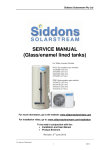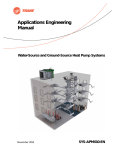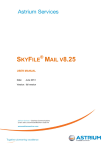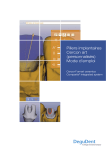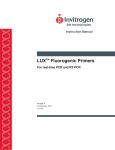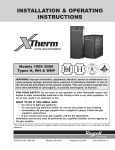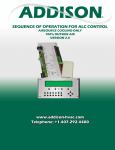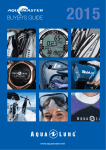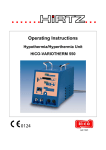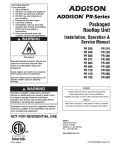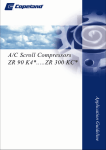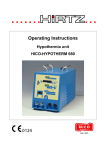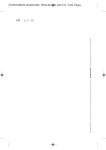Download Guide To Heat Pump Water Heating
Transcript
GUIDE TO HEAT PUMP WATER HEATING FOR CONDOMINIUMS, COMMERCIAL AND INSTITUTIONAL FACILITIES ENERGY SERVICES DEPARTMENT GUIDE TO HEAT PUMP WATER HEATING FOR CONDOMINIUMS, COMMERCIAL AND INSTITUTIONAL FACILITIES (Revised September 2003) In 1994, the Edison Electric Institute presented the Edison Award to Hawaiian Electric Company for exceptional application of efficient electrotechnologies. HECO was honored for meeting its customer needs to control energy costs and to reduce Hawaii’s dependence on imported oil through introduction of heat pump technology. The Edison Award honors distinguished leadership, innovation, and for the contribution to the advancement of the electric utility for the benefit of all. GENERAL 1. The information contained in this Heat Pump Water Heating (HPWH) Guide is intended as a guide for informational purposes only. Hawaiian Electric Company, Inc. (HECO) is not responsible for the safe or proper installation of HPWHs or any electrical equipment installed beyond its meter and does not, by publication and distribution of this booklet, assume any such responsibility. As such, HECO disclaims any implied warranties of merchantability and fitness for particular purpose. Please consult a licensed engineer, contractor or an electrician for additional information regarding the design and safe installation of HPWHs or any electrical equipment. 2. This HPWH Guide is not a professional manual on designing, specifying, or installing HPWH systems. HECO’s intent is to provide practical and useful information that will give our customers (1) a general overview of HPWH technology, (2) an understanding of how and why HPWHs can save you money, (3) typical routes available to implement HPWH systems, and (4) some tips on maintaining your HPWH system. 3. If you have any questions regarding information contained within this booklet, please contact your HECO account executive in our Energy Services Department at (808) 543-4751. TABLE OF CONTENTS SECTION 1. INTRODUCTION............................................................................................................. 1 SECTION 2. HEAT PUMP WATER HEATING TECHNOLOGY................................................... 2 WATER HEATING SYSTEMS ..................................................................................................................... 2 TYPES OF HEAT PUMPS ........................................................................................................................... 3 Air-To-Water Heat Pumps .................................................................................................................. 3 Water-To-Water System Heat Pumps ................................................................................................. 5 HEAT PUMP WATER HEATING EFFICIENCIES ........................................................................................... 6 SECTION 3. ECONOMICS OF A HEAT PUMP ................................................................................ 7 SECTION 4. YOUR HOT WATER SYSTEM EXPECTATIONS..................................................... 8 SECTION 5. CONVERTING TO A HEAT PUMP ........................................................................... 10 SECTION 6. ACQUISITION OF A HEAT PUMP............................................................................ 12 SECTION 7. OPERATING AND MAINTENANCE .......................................................................... 14 OPERATING ............................................................................................................................................ 14 MAINTENANCE AND SERVICING ............................................................................................................. 14 APPENDIX I ........................................................................................................................................... 18 PROJECT DETAILS ............................................................................................................................ 18 APPENDIX II.......................................................................................................................................... 21 CONVERSION FACTORS.................................................................................................................. 21 APPENDIX III ........................................................................................................................................ 22 TYPES OF COMPRESSORS AND HEAT EXCHANGERS AVAILABLE ..................................... 22 APPENDIX IV ........................................................................................................................................ 24 THE REFRIGERATION CYCLE........................................................................................................ 24 Background ....................................................................................................................................... 24 The Refrigerant Cycle ....................................................................................................................... 24 APPENDIX V .......................................................................................................................................... 25 SUGGESTED PREVENTIVE MAINTENANCE PROGRAM CHECKLIST ................................... 25 Daily Inspections: ............................................................................................................................. 25 Quarterly Inspection:........................................................................................................................ 25 12-month Inspection: ........................................................................................................................ 25 SECTION 1. INTRODUCTION For many customers, water heating is a major energy user and accounts for a large portion of the utility bill. There are four common ways to heat water: electric resistance heaters, fossil fuel burning heaters, solar systems, or heat pump water heaters (HPWHs). Traditionally, Hawaii consumers have utilized conventional electric resistance or fossil fuel burning water heaters to heat their water. Although, the equipment and installation costs for these systems are low, they are inefficient and costly to operate when compared to HPWHs. Large residential condominiums, hotels, hospitals, restaurants, and other commercial businesses have many uses for hot water. Dishwashers, laundry equipment, pool heaters and HVAC reheat systems consume large volumes of hot water. In these locations, the electric heat pump offers an energy efficient alternative to heating water that can provide significant energy savings. Since 1980, many HECO customers have reduced their cost to heat water by installing heat pump water heaters. In fact, Hawaii has become a national leader in the use of heat pump systems for heating domestic hot water. In Hawaii, over 60,000 living units receive their hot water supply from energy efficient heat pump technology. In 1994, HECO was honored by the Edison Electric Institute with the Edison Award for meeting our customer needs and reducing Hawaii’s dependence on imported fuel oil by introducing and marketing heat pump water heating technology on a mass scale. Heat pumps have proven to be highly successful in reducing the monthly water heating costs of many commercial facilities and residential customers. Typical units are three to six times more energy efficient Page 1 than fossil fuel burning heaters and about two to five times more energy efficient than electric resistance units.1 Based on our experience in responding to customer requests for assistance, HECO believes that the critical first step for people in decision-making positions is to have a reasonable working knowledge of the various financial and economic differences of each water heating option and particularly, a good working understanding of the operating cost savings of the heat pump. This HPWH Guide is not a professional manual on designing, specifying, or installing HPWH systems. As such, HECO disclaims any implied warranties of merchantability and fitness for particular purpose. HECO’s intent is simply to provide practical and useful information that will give our customers (1) a general overview of HPWH technology, (2) an understanding of how and why HPWHs can save you money, (3) typical routes available to implement HPWH systems, and (4) some tips on maintaining your HPWH system. We recommend that our customers consult with a licensed engineer to gather data, size, design, and specify a heat pump water heating system. We believe that you will find this a useful Guide to HPWHs and the staff of the HECO Energy Services Department welcomes suggestions you may have to improve this Guide. 1 Based on a 70% efficient gas water heater and a 92% efficient electric resistance water heater. Efficiencies are dependent upon a number of variables and these comparisons are estimates only. SECTION 2. HEAT PUMP WATER HEATING TECHNOLOGY Water Heating Systems There are four common ways to heat water. Some have higher initial capital costs (first cost) while other cheaper systems cost more to heat water (operating cost). The four water heating ways are described below: • Electric Resistance Heaters • Fossil Fuel Burning Heaters utilizing Diesel, SNG2 & Propane gas • Solar Water Heating Systems • Electric Heat Pumps Electric Resistance Heaters: This is the ubiquitous electric water heater installed in many local residences. Electric elements, located in the storage tank, directly heat the water. This type of equipment is readily available and has relatively low initial equipment and installation costs; however, the cost to heat water is high. This type of heater may not be appropriate for large commercial facilities that consume large amounts of hot water due to its slow heat recovery and high electrical demand. Solar: Solar water heating systems have been installed at many smaller condominiums and apartments. In Hawaii, solar systems have been predominantly successful in the single family and townhouse sectors because sun exposed space to install 2 to 4 solar panels is readily available. The economic attractiveness of solar systems is also significantly improved by the availability of 2 both utility rebates and a Hawaii State Tax Credit. Solar collectors (or solar panels) absorb the sun’s thermal energy and can heat water to temperatures as high as 160 degrees Fahrenheit. A solar system should be sized to provide a sufficient reserve of hot water supply during intermittent cloudy days. During sustained cloudy periods, a backup heater is used to produce hot water. The backup heating source is typically an electric resistance or fossil fuel burning heater. In Hawaii, HECO has actively promoted the installation of solar water heating systems in residences. HECO’s solar water-heating program leads the nation and is responsible for installing over 20,000 solar water-heating systems statewide. The solar sun’s energy provides most of the heat to produce hot water. Electricity is used to operate a watercirculating pump, and to provide backup heat during extended periods of cloudy weather. In spite of its energy efficiency, a commercial solar water heating system requires a large amount of sun-exposed space to accommodate the installation of solar panels. In locations with high hot water demands and extremely limited exterior sun exposed space, there may be insufficient area to install the required number of solar panels to meet hot water demand. In these locations, installation of HPWHs may provide a practical alternative to solar water heating systems. It is also possible to combine solar water heating systems with HPWHs in a hybrid arrangement. The 35% State Energy Tax Credit for solar water heating systems has been extended through December 31, 2007. SNG denotes Synthetic Natural Gas. Page 2 Fossil Fuel Burning Heaters: In Hawaii, diesel, synthetic natural gas (SNG) or propane gas are typical fossil fuels are used to supply fuel to a burner, which in turn, heats the water stored in a storage tank much like a tea kettle on a gas stove. Since fossil fuel burning heaters rely on heat generated from the combustion of fuels, they are typically less efficient and subject to higher thermal and standby losses from heat escaping through the flue. The overall efficiency and initial equipment and installation costs are relatively low; however, the cost to heat water is high. Heat Pump: A heat pump uses a simple vapor compression refrigeration cycle to extract heat from the air or from a warm water source such as a central air conditioning system and transfers that heat into hot water for a building or commercial facility. This Guide focuses on heat pump water heaters (HPWHs). The initial equipment and installation cost for HPWHs is moderately high; however, the cost to heat water is usually 25% to 40% of the cost of gas heating. Note: The 20% State Energy Tax Credit for heat pumps expired in June 2003. Summary of Water Heating Choices Types of Water Heater Electric Gas Solar Heat Pump Initial Cost Low Low High Moderate Operating Cost High High Very Low Low Efficiency 92% 70% N. A. 300-600% Hawaii’s year-round warm to temperate climate is an ideal environment for an electric heat pump. High volume hot water users that have central electric resistance or fossil fuel burning waterheating systems are encouraged to seriously research and compare the economics and energy efficiency of a heat pump. Heat pumps have been installed at hundreds of condominiums, hotels, and other large commercial and institutional facilities since 1980. Types Of Heat Pumps Two basic types of heat pumps are commonly installed in Hawaii. They are the Air-To-Water System (also referred to as an “air-source” heat pump) and the Water-To-Water System (or “watersource” heat pump). Air-To-Water Heat Pumps In Hawaii, the Air-To-Water (ATW) heat pump is more commonly selected by business owners and condominium owners associations who do not have central air conditioning. ATW heat pumps are available as packaged systems and are often installed on the rooftops where there is available space and abundant warm circulating air. ATW heat pumps can also be installed indoors such as in a large equipment room or in the basement. For indoor installations; however, it is important to provide adequate outdoor circulating air for proper operation and efficiency. The lack of warm circulating air will reduce the hot water produced by the heat pump to a point below its rated heating capacity. Although there are design limitations, the cold air that is discarded by the ATW heat pump may be utilized for spot cooling or to augment existing air conditioning equipment. In many commercial food service facilities and restaurants, the cold air discharge has been creatively utilized to help cool the kitchens. ATW heat pumps are available in a wide range of sizes. A preliminary analysis can be completed by HECO; however, we recommend that a licensed engineer be consulted when commercial facilities are interested in retrofitting an existing hot water heating system to new energy efficient electric heat pump water heater systems. Page 3 The photograph below shows a typical ATW heat pump in a “split” configuration whereby the evaporator and condenser sections are in separate modules. You’ll notice that this ATW heat pump is substantially constructed of stainless steel sheetmetal to resist Hawaii’s salt air environment. This particular unit employs reciprocating compressors and serves a high rise condominium complex. Page 4 Water-To-Water System Heat Pumps A Water-To-Water (WTW) heat pump is more appropriate for hotels, condominiums and commercial buildings that have high hot water heating loads and central air conditioning. WTW heat pumps extract heat from cooling tower (typically 85° - 95° F) or return chilled water (typically 50° 55° F) circulating in a building air conditioning system. Either of these water sources can be effectively utilized as heat sources. When heat is extracted from the cooling tower water, it lowers the temperature of the water and, in turn, can reduce the operating hours and energy usage of the cooling tower fan(s) or lower the temperature of the water leaving the cooling tower. Heat contained in chilled water can also be used as a heat source for a WTW heat pump. In this design arrangement, the heat pump acts to pre-cool the return chilled water and reduces the workload on the chiller, which lowers energy consumption. Since WTW heat pumps provide both cooling and water heating benefits, they are highly energy efficient and provide significant energy savings. This double bonus makes installation of WTW heat pumps financially attractive for hotels, large condominiums, and hospitals. Water-source heat pumps are widely used in Hawaii. The photograph below shows a typical WTW heat pump built as a “packaged” module that allows easy installation at the jobsite. This particular unit is installed at a large hotel in Waikiki and employs a pair of screw compressors and brazed plate heat exchangers. Page 5 Heat Pump Water Heating Efficiencies The primary advantage of the heat pump water heater (HPWH) over conventional water heating systems utilizing fossil fuel burning heaters or electric resistance units is its ability to use a small amount of energy (input energy) to produce a large volume of hot water (output energy). Engineers and energy specialists use the term “Coefficient of Performance” (or COP) to identify the energy efficiency of a system or a piece of equipment. The COP of a water heating system is defined as the output energy divided by the input energy. Typical COPs for Heat Pump Water Heaters Producing 140°F Hot Water4 Air-Source Heat Pumps Residential Unit Small Commercial Unit Commercial Package Unit Condenser Water-Source Heat Pumps (90°F Source) Reciprocating, Screw, or Scroll COP = Output energy (Btu)3 Input energy (Btu) 3 Chilled Water Source Heat Pumps (54°F Source) Reciprocating, Screw, or Scroll Typical Htg COP5 2.5 3.0 3.5 Typical Htg COP5 3.6-3.7 Typical Htg COP5 2.7-3.2 4 3 One British Thermal Unit (Btu) is defined as the amount of energy it takes to heat one pound of water, one degree Fahrenheit. Centrifugal compressor driven, water-source heat pumps are more efficient but recent years have seen limited installation of this larger type of heat pump in Hawaii. 5 COP values are heating only and do not include any cooling benefits. Total COP can be characterized using several methods and will be higher than the heating-only COP. Page 6 SECTION 3. ECONOMICS OF A HEAT PUMP Conventional water heating systems using SNG or propane gas cost significantly more to heat water than heat pumps. The reason is that heat pumps operate at high efficiencies and take advantage of waste or ambient heat. Your economic assessment of water heating systems or proposals submitted by vendors and contractors should be based on sound financial analysis. It is highly recommended that you ensure that proposals include all costs, expenses, and the cost of capital, including possible system replacement expense. Any omission can lead to an erroneous conclusion, especially if you are reviewing different water heating systems. Life Cycle Cost Analysis: To accurately compare the economics of a central fossil fuel burning waterheating system to a heat pump water heater, all costs to purchase, install, operate and maintain each system should be included and analyzed using a life cycle cost analysis. As the name implies, this type of cost analysis looks at all costs and benefits over the anticipated life of water heating alternatives. If the lives of alternatives are different, then replacement costs must be factored in for those systems that have an expected life that is shorter than the longer-lived alternative. For water heating systems, the life cycle analysis should cover an extended period, such as 15 years, because a properly maintained and operated heat pump can last longer than 15 years. Costs and expenses could be categorized under first cost, operating cost, or maintenance cost. First Cost: The first cost of a heat pump consists of the following items: 1. System design fee 2. Cost of the basic heat pump equipment 3. Cost of auxiliary equipment such as circulating water pumps, heat exchangers, storage tanks, enclosures, ductwork (in the case of ATW units), automatic controls, electrical apparatus, etc. 4. Installation hardware and labor (piping, insulation, valves, gauges, strainers, etc.) 5. Special handling equipment (for example: cranes, helicopter lifts) 6. Startup and Commissioning 7. Equipment and System Warranties Although the costs may vary, the first cost of a heat pump is generally higher than a new central gas water heater or electric resistance heater. Since first costs are higher for the HPWH system, it is important to select the optimum type and size of the heat pump and account for the costs of hot water storage tanks, pumps, and any other items. We recommend that you maximize the efficiency and run time of the HPWH system while providing for appropriate supplemental and/or backup water heating. Page 7 SECTION 4. YOUR HOT WATER SYSTEM EXPECTATIONS The overall design objective for heat pump water heating systems should be to meet the building owner’s (and tenant’s) hot water needs in a cost-effective manner. To achieve this goal, we first recommend that the designer select and size the heat pump water heating system to provide the greatest possible return on investment. This is accomplished by careful selection and sizing of heat pump equipment and hot water storage tanks. Our second recommendation is that the designer integrate gas water heaters for supplemental and/or backup service to accommodate peak hot water loads and for periods of cool weather (particularly for airsource heat pumps), and also to allow for periods where the heat pumps must be serviced or undergo repairs. In some cases, it may not be economically feasible to size the heat pump equipment to meet the entire water-heating load of a facility since peak hot water demand conditions occur occasionally during the day. Over sizing a heat pump to meet peak hot water demand conditions results in higher capital costs and lower run time. An oversized unit will affect payback and reduce the customer’s return on investment.6 Please consult a licensed engineer to carefully review the sizing of your heat pump water heating system and to prepare design drawings as required for permit application. HECO recommends that customers retain an engineering consultant that has experience in designing heat pump water heaters, especially when it involves converting an existing building using fossil fuel burning 6 Should you elect to rely exclusively on your heat pumps for all of your hot water needs (i.e. no backup or supplemental heaters), please ensure that this requirement is communicated to your engineering consultant and any other party involved in assisting you with the design and installation of your heat pump system. heaters to heat pump water heaters. An experienced licensed engineer is required to determine optimum sizing of the heat pump. Optimum sizing provides a higher return on investment for heat pump equipment and improves the payback. Paybacks typically range between 3 to 7 years, depending upon whether the project is replacing old inefficient conventional water heaters burning fossil burning fuels or replacing an older heat pump7. Operating Costs: A heat pump water heater will produce hot water at a lower cost than conventional water heating systems fueled by SNG or propane gas. How can an electric heat pumps produce hot water for less cost than gas? The simple answer is that a heat pump delivers more energy than it uses. The heat pump takes advantage of available heat from the air or a water source. Depending upon outdoor temperatures, an ATW heat pump can deliver about three times more energy than it consumes. Since a WTW heat pump can also provide additional cooling savings, a WTW heat pump can deliver about five to six times more energy than it consumes8. Maintenance Cost: The maintenance cost for heat pumps is higher than gas systems. Unfortunately, system maintenance is often ignored or not considered as essential. This is not a prudent financial management decision. Routine maintenance provides reliable operation and extends equipment life, thereby protecting your initial investment and giving you long-lived savings. 7 Your design consultant can provide more exact projections of economic payback for a heat pump project. This Guide simply provides general observations. 8 Based on the total benefits of both heating and cooling. Page 8 Section 7 covers operating and maintenance in detail. Heating Cost Example: Let’s take a representative residential condominium to compare electric, fossil fuel gas, and heat pump water heaters. Example: A 300-unit, one-bedroom condominium has an average hot water usage of 35 gallons per apartment unit per day9. Hot water is supplied at 130 degrees Fahrenheit to each apartment unit. The condominium does not have central air conditioning. The daily output energy to heat the required amount of hot water for this condominium is: 5,254,200 Btu/day calculated as follows: 300 x 35 gal/unit/day x 8.34 lb/gal x (130 deg 70 deg) x (1 Btu/°F/lb.) = 5,254,200 Btu/day How much energy will a water heating system consume (input energy) to produce the required gallons of hot water (output energy)? It depends on the efficiency or coefficient of performance (COP) of the system. For this condominium, let’s consider the application of an air-source heat pump: Efficiencies/COP Water Heater Type Electric Gas ATW Heat Pump Required Daily Input Energy (energy consumption) Water Heater Type Electric Gas ATW Heat Pump Daily Energy Consumed in Respective Energy Units Water Heater Type Electric Gas ATW Heat Pump Daily Energy Units 1,673 kwh 75 therms 440 kwh Daily Water Heating Costs Water Heater Type Daily Energy Cost * Electric 1,673 kwh x $0.11/kwh = Gas 75 therms x $1.56/therms = ATW Heat Pump 440 kwh x $0.11/kwh = $184.03 $117.00 $ 48.40 Yearly Water Heating Costs Water Heater Type Electric Gas ATW Heat Pump Annual Energy Cost* $67,171 $42,705 $17,666 *Gas and Electric energy costs are illustrative only and will generally vary with time. Heat Pump Leasing and Operating Costs versus Gas Costs10 New Heat Pump System: Typical Efficiency/COP 0.92 0.70 3.50 Daily Input Energy 5,711,087 Btu 7,506,000 Btu 1,501,200 Btu $101,000 Energy Savings $42,705 - $17,666 = $25,039/yr HP Maintenance $1,200/yr Simple Payback $101,000 = 4.23 years ($25,039-$1,200) 10 9 This example is based on an assumption that each condominium unit uses exactly 35 gallons per day of hot water and does not involve the actual sizing process for the heat pump. Actual costs and savings may differ according to type of equipment specified and utility costs for your location. Please consult with a licensed engineer and/or contractor to design and estimate actual costs and savings for your location. Life cycle analysis using current utility data and actual costs should be employed. Page 9 SECTION 5. CONVERTING TO A HEAT PUMP Converting from a conventional water heating system (using fossil fuels) to a heat pump can result in a substantial reduction in your utility costs. The following is a four-step process, which has worked for many Hawaiian Electric customers in their adoption of heat pump water heating. Step 1 - Review Your Current Cost For Water Heating Reviewing your utility bills is an important first step. To capture seasonal and weather related energy usage trends, a review of 12 consecutive months is recommended. Upon request, HECO can provide a 12-month electric billing history report. Your fuel supplier can also provide billing histories for SNG and propane. Since monthly utility bills represent total usage, the next step is to separate, as best as possible, the water heating usage from other appliances such as gas clothes drying, cooking, and any other gas appliance you or your facility may have. Although not common, hot water consumption and cost may be on several monthly bills if you have more than one electric or gas meter. So it will be necessary to analyze all bills. In addition to utility bills, the water heater’s historical maintenance and service/repair costs should be identified and included to capture the most accurate total cost of heating water. These costs should include both emergency type repairs and scheduled or preventive maintenance work. Step 2 - Feasibility Study With the information gathered in Step 1, a feasibility study should be completed to compare your current water heating system to an electric heat pump. A good feasibility study will provide a life cycle cost analysis that includes a comparison of first cost, utility cost, maintenance cost, and financing options such as leasing. The life cycle analysis should be done over an extended period such as 15 years. If applicable, the feasibility study should also look at air-source vs. water-source heat pumps and beneficial utilization of the cool air produced by air-source heat pumps. A professional engineer can best complete the feasibility study. Step 3 - Preparing To Design of System As we discussed in Section 4 of this Guide, it is important to communicate your hot water system expectations to your chosen design consultant, equipment supplier, or to anyone with whom you are soliciting input on your heat pump project. Your expectations would include such items as: (1) equipment lifetime (2) noise levels (3) requirement for beneficial use of cool air from air-source units (4) baseload versus peaking duty (5) availability of gas backup heaters in case of heat pump failure (6) hot water recovery time (7) minimum acceptable hot water delivery temperatures (8) minimum acceptable hot water storage temperatures (9) specific means of controlling your heat pump(s). In the feasibility study, your design consultant will have selected (and discussed with you) the heat pump(s). Once the equipment is selected, you will need to identify where the heat pump can or should be located. The appropriate location may not be immediately obvious; weather protection, drainage, noise, vandalism, and physical damage (such as from vehicles) must be kept in mind when determining a suitable heat pump location. Take advantage of both a consulting engineer and an experienced heat pump contractor to help you determine the most appropriate location and have them Page 10 explain why they are recommending a particular location. In addition to identifying the best location for the heat pump, the following system design issues need to be considered to help brief the professional engineer or to obtain bids from contractors: • Space and access for maintenance. • Hot water storage tank(s) size and type (vertical, horizontal, epoxy or glass-lined steel, plastic lined composite tanks) including nozzle arrangements. • Electrical system requirements – do you have adequate power for the heat pump system? • Service equipment, and future equipment component replacement requirements. • • Adequate and nearby heat source for the evaporator. Adequate ventilation (especially for air-source heat pump evaporators). • Beneficial use of cool air from airsource heat pumps. • Structural requirements – is the floor or roof strong enough to support all equipment components? • Mechanical noise and vibration must be addressed. There are several noise isolation devices and acoustic materials available to abate noise and vibration. The possibility of locating mechanical components away from occupied portions of your building and surrounding neighbors should be investigated. • Security and protection from weather and vandalism is important. • Weather Protection - corrosion is a major problem in Hawaii’s moist, salt-laden air. The materials that you select for your heat pump system play a vital role in the lifetime of this equipment. Our recommendation is to purchase equipment that uses stainless steel sheet metal, fasteners (hinges, bolts, nuts, brackets, etc) and (if you can afford it) framing and structural components. Electrical enclosures should be stainless steel or plastic if exposed to the weather. If available, evaporator coils on airsource heat pumps should employ thick fins with wider fin spacing and be copper or aluminum with a factory-applied, protective coating. Section 7 addresses the benefits of a preventive maintenance program. Step 4 - Designing and Installing the Heat Pump System After completing the previous steps, you will be ready to start the process of designing and installing a heat pump system. There are two general approaches, which have been used that are explained in more detail in Section 6. The first approach, Plan and Specification, is to hire a professional engineer to prepare the system design and equipment/installation specifications which will be used to obtain bids from contractors. A second approach, Design-Build, would be to have contractors submit proposals that include both the design work and installation. Page 11 SECTION 6. ACQUISITION OF A HEAT PUMP Installing a new heat pump system or replacing an old unit can represent a substantial financial commitment. Therefore, it is important to get the best price and quality performance from your contractor. Also, obtaining financing can be a key to a successful project. This section will provide insights on various approaches to contracting and financing a heat pump system. Contracting The two common approaches to acquire a heat pump system are the Plan and Specification Method and the Design-Build Approach. Each approach has advantages and disadvantages. The Plan and Specification method begins with the retention of a design professional, such as a licensed mechanical engineer. He will prepare plans and specifications, thus the name. Because of the extensive use of heat pumps in Hawaii, there are many qualified engineers capable of designing heat pump hot water heating systems. The engineer will usually begin by inspecting and assessing your existing system, review your specific water-heating requirements (both past and future), and submit appropriate recommendation(s) for your review. Note The engineer’s assessment should take advantage of the availability of ultrasonic flow and energy meters to accurately assess your facility’s hot water usage pattern. Several weeks are generally considered the minimum monitoring period and longer periods would be preferred. If you require assistance in determining your hot water usage, please contact your HECO Account Executive. Upon selecting the most favorable project recommendation, the engineer will finalize the plans and specifications that will then be used to obtain firm pricing proposals from contractors. The engineer then becomes an advocate for the customer by ensuring the quality of installation. The Plan and Specification method usually requires an up-front engineering fee that basically covers the estimated number of hours to complete the drawings, the number of drawings required, and other planning and specification work. The drawings are necessary, as they must be submitted with the permit application. This fee has been a concern for some customers but is a wise investment. The Design-Build approach does not normally require an up-front fee commitment. In this approach, you provide a description of the project requirements to contractors. Interested contractors will prepare a complete proposal with a firm cost to design, purchase, install, and commission your heat pump. The Design-Build approach will generally result in individual proposals having substantial cost and design differences. Correctly analyzing each proposal and selecting the best system is important if pursuing this alternative heat pump acquisition method. Project Contract We strongly advise that you obtain a firm contract for construction to minimize or avoid legal and contractual risks. Do not proceed without a signed contract. Retain an attorney to prepare the contract and other related documents. It is necessary for many business transactions today. The role of a good contract is to minimize or avoid Page 12 misunderstandings between you and your contractor while providing sound legal ground in the event of an unforeseen dispute. Partial List of Contracting Issues to Consider in Heat Pump Installations 1. Price and progress payment schedule during construction. 2. Firm definition of project scope including the reference to specifications and drawings in the contract. Be sure to check that references are made to specific documents to be used by the contractor (example: “Plans and Specifications, Revision 3 prepared by XYZ Consultant, dated Jan 5, 2003”). 3. Schedule of completion, remedial mechanism if delays occur, and limitation on outages required for contractor to complete work. 4. Contractual requirements to ensure compliance with federal, state, and local ordinances by contractor including all applicable permits and inspections. 5. Insurance requirement for both owner and contractor. 6. Defining contractor status to insure they are an independent contractor. 7. Right of owner to approve all subcontractors. “parts and labor”, or a combination of both. In most cases, we recommend that you purchase extended warranties (5year duration) for major components such as compressors. 10. Procedure for handling changes to the scope of work and pricing. Financing Options For many entities, having available funds to pay for a major capital outlay such as heat pumps is a substantial hurdle. To overcome these hurdles, financial institutions in Hawaii have developed leasing programs. Leasing avoids the need for a large, unscheduled assessment. In many cases, the combined amount of the monthly lease payments and the cost of electricity consumed by the heat pump may be lower than the monthly operating expense of the previous central water heating system. Thus, leasing is an option that can result in a positive cash flow from the day the heat pump starts up. In addition to leasing, heat pumps can be financed through conventional loans or other financial mechanisms. Hawaii State Energy Tax Credits Although the Hawaii State Tax Credit is not available for heat pumps, they are a cost effective means of heating water in Hawaii. 8. Parking, access, and removal of construction material including proper disposal and handling of any possible hazardous materials. 9. Turn over and acceptance procedure for new or modified equipment including operating and maintenance manuals, equipment and system warranties, and As-Built Drawings. Be sure to check on the specific nature of your warranties – is it “parts-only”, Page 13 SECTION 7. OPERATING AND MAINTENANCE Operating Upon start-up (and commissioning), your typical, well-designed heat pump system will run between 10 to 16 hours per day, 365 days a year. The system will be fully automated and provide sufficient hot water to meet most of your requirements. HECO recommends the use of SNG or propane-fired hot water heaters for supplemental heating during peak loads or atypical hot water demands. The gas heater can also supplement or replace heat pump capacity during maintenance and repair periods. If you do not wish to utilize SNG or propane fuel for supplemental heating, then advise your design consultant at the start of the design process so that he can add extra heat pump and storage tank capacity to your system. Although the system is fully automated, your condominium manager, facilities supervisor, or your heat pump maintenance contractor should have a working knowledge of its components and operating characteristics. Since you will be making a significant investment in your heat pump system, it is important to obtain all of the pertinent documentation for your heat pump system. Standard practice is to have the installation contractor provide the following items: 1. Onsite Training to Owners Personnel or Representative 2. Several copies of the Operation & Maintenance Manuals including a Parts List for each piece of equipment. 3. Operating Instructions / Sequence of Operation 4. “As-Built” Drawings During the Onsite Training, the installation contractor will review the Operating & Maintenance (O&M) Manuals and identify each piece of equipment and key devices on the Parts List such as thermostats, electrical breakers, reset switches, gauges, etc. The Operating Instructions and Sequence of Operation should provide clear and concise descriptions of the heat pump operation. The installation contractor should clearly explain the various heat pump components, normal temperature set points, typical refrigerant pressures, voltage and amperage values, operational and alarm indicators or lights, and proper valve positions. It is very important to have these manuals and the As-Built Drawings of the heat pump on file as references. As-Built Drawings are the documented mechanical, electrical, and plumbing detailed plans of the heat pump system. It is also advisable to request that documents be provided to you in archival form (such as on a CDROM) in an easily useable format such as Adobe PDF.11 HECO suggests that these drawings be provided to you as a prerequisite to final payment or as part of the “project acceptance” process. Maintenance and Servicing From the time you start up your heat pump system, a preventive maintenance program is highly recommended to maintain energy efficient performance, reliable operations, and ensure equipment longevity. The program should consist of sound refrigeration, plumbing, and electrical, and housekeeping practices to 11 PDF denotes a document format called Page Definition Format that is widely used to distribute documents. Page 14 ensure trouble-free performance and to avoid major and costly repairs. The following are recommended maintenance and service guidelines: 1. Air Filters: For some air-to-water heat pumps, the evaporator may be furnished with air filters. Clean the filter periodically and replace it when necessary. Dirty filters restrict airflow and allow particulates to penetrate and clog coils resulting in reduced heat transfer efficiency and accelerating corrosion. 2. Lubrication: Bearings on fans and circulating pumps will generally require periodic lubrication. Refer to manufacturer’s Service Manual for recommended lubricant type, viscosity, and frequency. 3. Evaporator Cleaning: For Air Source heat pumps, evaporator coils will require occasional cleaning to maintain efficient heat transfer. In Hawaii, systems or their major components are exposed to corrosive salt laden air and need cleaning and corrosion preventive measures to extend equipment life. Preventive measures will help to maintain the factory rated heating capacity and efficiency. Care should be taken to avoid damage to coil fins and do not use cleaning agents that will attack the fins, tube materials, or protective finishes or coatings. For water-source heat pumps, special cleaning solutions are available to remove corrosive deposits. Always follow the manufacturer’s cleaning instructions. Maintenance intervals will depend on the water quality, however, the general rule is to inspect and clean annually. When a condenser water source heat pump is installed, a properly maintained cooling tower water system can extend the intervals between cleaning. A reputable water treatment company can help you with a water treatment program. You may also want to consider the installation of a water filtration system or an isolation plate heat exchanger for particularly dirty water sources. 4. Storage Tank: Steel hot water storage tanks generally are provided with anode rods for protection against internal tank corrosion that is created when oxygen in water is heated. The expected life of the anodes will vary according to the water quality of your condo, hotel, or commercial building. Tank manufacturers recommend that the anode rods be inspected every 6 to 12 months. Also, inspect for exterior surface corrosion and leaks in the insulation vapor barrier, especially around nozzles and other penetrations. These areas should be well sealed. Note Composite tanks are not equipped with anode rods, as the plastic lining will not corrode 5. Condenser Cleaning: There are two common condenser types: shell-and-tube and tube-in-tube. Depending upon water quality, scaling or lime accumulation on the heat exchanger surface will reduce the heat transfer capacity and efficiency. A symptom of excessive scaling is reduced hot water temperature output and abnormally high condensing pressures. This may also lead to nuisance heat pump compressor trips. Follow the manufacturer’s cleaning instructions to insure that the chemical de-scaling Page 15 solution is compatible with heat exchanger materials. • 6. Strainers: Inspect pipe strainers periodically and clean if necessary. Clogged strainers restrict water flow and increase pumping energy consumption. 7. Fan Wheels / Blades: Inspect on a quarterly basis for wheel imbalance, loose setscrews, belt condition and tension if beltdriven. 8. Refrigerant Charge: The refrigerant charge should be inspected through the site glass or by checking operating pressures. Monthly inspections should be adequate. Facility staff or maintenance workers must be licensed to handle refrigerants. Suggested Preventive Maintenance Program Check List: Daily Inspections: • Inspections should be done when the heat pump equipment is operating. Record all data in a Daily Log. • Operating refrigerant pressures • Electrical – Check amps and volts on each phase (for three phase systems) and inspect the condition of the power wiring and tightness of the wiring terminals and lugs. Loose connections will cause heat buildup that could lead to failure. • Entering and leaving water temperatures and pressures • On non-sealed compressors, check compressor oil level • Check oil pressures • Check general operating conditions • Observe the refrigerant site glass (bubbling, clear, etc.) Observe and report abnormal sounds or vibration and/or compressor short cycling. Shortcycling, as the name implies is a condition where the heat pump compressor(s) starts and stops in short intervals. This can rapidly destroy compressor motors due to excessive heat buildup. Quarterly Inspection: • Check condition of air filters; clean or replace as necessary. • Lubricate fan and motor bearings, as necessary. Follow manufacturers instructions on selection of lubricant type, viscosity and bearing lubrication instructions. • Inspect fan wheel and blades • Inspect fan belts and sheave alignment. Replace and adjust tension as necessary. • Inspect condition of condensing equipment. Clean as necessary • Inspect and remove/repair damaged insulation on piping and hot water storage tanks. • Inspect and seal defective joints on hot water insulation jacketing. If water has made its way underneath the jacketing, then it will probably require the removal of the insulation and replacement of both the insulation and jacketing. This applies to both piping and storage tanks. 12-month Inspection: • Inspect the non-stainless steel components for corrosion. Clean, treat with rust removing solution, and coat with rust inhibiting industrial grade paint. Page 16 • Inspect and remove/repair damaged insulation on piping and hot water storage tanks. • Inspect and seal defective joints on hot water insulation jacketing. If water has made its way underneath the jacketing, then it will probably require the removal of the insulation and replacement of both the insulation and jacketing. This applies to both piping and storage tanks. • Inspect and clean pipe strainers • Inspect and clean evaporators and condensers • Replace worn or frayed drive belts • Inspect condition of electrical relays, starters, wiring, and wire terminations. Operating Guidelines: 1. Do not operate the heat pump beyond the manufacturer’s recommendations. Premature failures have been linked to operating the heat pump beyond its recommended limits such as exceeding its maximum water temperature limit and or to ignore excessive stops & starts due to defective controls or low refrigerant levels. 2. Non-stainless steel components such as the coils, cabinets, housings, brackets, hinges, and steel tanks that are exposed to the weather and salt laden air will experience accelerated corrosion. These components should be coated with a rust inhibiting coating. Attentive and immediate remedial action in early stages of corrosion will minimize maintenance cost and extend your equipment life. insulation will accelerate corrosion process. Seal all insulation vapor barriers and leaks with a waterproof sealant. 4. Maintaining a daily log of pressures and temperatures will assist and expedite the troubleshooting process. The daily record, like your health record, will be helpful to the attending service technician by alerting him to trends, which may indicate where the malfunction is and determine corrective adjustments before a catastrophic failure. A daily log provides an excellent overview of the operating characteristics of your heat pump. Review the daily log periodically to identify unusual changes. Maintain a file of all service call reports. If available, have your digital control system perform automatic logging of key operating variables. Many systems can store data on workstations and/or print out alarms and other operating variables automatically. Most preventive maintenance programs generally provide ample lead-time for possible component replacements to ensure that the required equipment and parts are available and that work will be conveniently scheduled. When in-house staff is limited, there are many heat pump contractors who provide preventative maintenance contracts. A maintenance service contract can be customized to fulfill your requirements. 3. Prevent water from leaking into and saturating tank and equipment insulation. Wet Page 17 APPENDIX I PROJECT DETAILS A heat pump system can be divided into 3 components: • Heat Pump Equipment • Auxiliary Equipment • Installation of Equipment 1. Heat Pump Equipment Many heat pumps installed in Hawaii are factory-assembled units (“packaged” units) containing a compressor, motor, electrical panel, controls, and heat exchangers. For large heat pumps, components could be designed and specified separately and assembled on site. This so-called “built-up system” enables the professional designer greater flexibility in selecting larger heat exchangers and high-efficiency compressors to design the most energy efficient system for his client. Appendix III describes the various types of compressors and heat exchangers available in packaged units. payback period by only a few months but you will enjoy lower operating monthly savings for the full life of the system. 2. Auxiliary Equipment Auxiliary equipment is that part of the heat pump water heater system that is not included in the packaged unit. Auxiliary equipment includes storage tanks, circulating pumps, pipe and valves, electrical feeders and miscellaneous apparatus. These auxiliary items can be specified by your consulting engineer, or in some cases, by the equipment vendor. Selection of engineers and contractors is discussed later in this section. Storage tanks: A well-designed system will store enough hot water to meet your expectations. Storage tanks are used to smooth out the demand for hot water throughout the day and they allow a smaller (less costly) heat pump to operate for a longer time for maximum return on your investment. Manufacturers or manufacturer’s representatives for packaged heat pump equipment can provide price quotations. These suppliers work closely with local consulting engineers and contractors. Be sure to factor in the shipping of the equipment from the mainland to Hawaii and then from the dock to your building. In general, greater storage volume is more desirable; however, larger tanks also have the potential of increased heat loss, which is a natural phenomenon. Insulating the tanks minimizes heat loss and the additional cost for quality insulation is recovered quickly. Tank material should be of top quality and must meet building code requirements. We recommend that your new heat pump design consider the highest possible efficiency and the best construction you can afford. The heat pump will operate every day and its payback period is a relatively short 3 to 7 years, so your economic analysis should favor an energy efficient system. The marginal extra cost for high-quality materials may extend the In recent years, plastic-lined, fiberglass reinforced tanks have become more widely used in heat pump systems in Hawaii. These are sometimes referred to as “composite” or “FRP” tanks. These tanks are more costly than the standard steel tank but have a longer life due to their corrosion resistant nature. Page 18 Pumps: All-bronze or stainless-steel pumps are best for hot water, although bronze-fitted pumps have been used with good results. In-line pumps have proven the most satisfactory but the end-suction pump design may also be used. Generally, mechanical seals require less maintenance than packing. Piping: Piping is required for both refrigerant and for hot water. Also, waste piping is required for floor drains, relief valves, and evaporator condensate drain (for air-source units). Copper piping for refrigerant and for water is recommended. CPVC (plastic) pipe may be used for water but it is less durable. Piping must be installed with adequate hangers and supports and in accordance with local codes. Insulation: Good insulation and jacketing add significantly to potential energy savings. Insulation materials commonly used on tanks and piping includes glass fiber, urethane foam, polystyrene, and elastomeric compounds. Check the Building Code requirements for smoke and fire rating limitations for insulation in indoor spaces. Insulation thickness and heat loss should be evaluated carefully when specifying insulation. Remember that any recirculation water piping must be insulated to minimize heat losses. In retrofit installations, an existing building’s hot water recirculation piping may not be insulated. In this situation, you must size your heat pump to accommodate this loss of heat in the hot water system. It may not be practical or cost-effective to insulate pipes, which are difficult to access. Also, insulation should be protected with a cover or coating to prevent damage from human abuse (walking on or banging into) and from the weather (sun, wind, and rain). Designs should call for fabric wrapping (interior only) or covering with hard plastic or aluminum. For exterior locations, hard plastic or aluminum jacketing is mandatory. If pipe or tank insulation becomes wet, the heat loss to the ambient air will increase significantly; therefore, it is important to maintain the integrity of your hot water system insulation. Electrical Power: Heat-pump package units and water pumps require an adequate source of power. They require disconnect switches and starters mounted nearby. If power is not nearby, it will be necessary to bring a new feeder from an electric room to the equipment room. Most large heat pumps use three-phase power at 208 volts or 480 volts. Ensure that the electrical installation meets the National Electrical Code (NEC) requirements such as location, ratings, and clearance specifications. 3. Installation of Equipment Installation costs include labor, handling equipment (such as a crane or helicopter), structural changes (such as a floor pad, widening a door) and miscellaneous materials to complete the job. A structural engineer will determine structural requirements. The installation contractor is usually selected through bidding. In some cases, architectural enclosures must be installed in certain locations to hide equipment from view and/or for security and safety. Be sure to include the cost of the equipment enclosure – these costs can be significant depending on the architectural treatment required in your area. Refrigerants Most heat pump systems currently use R-22 or R-134a. R-22 is an HCFC while R-134a is an HFC compound. R-22 is thought to have a minor effect on ozone in the upper atmosphere, and because a suitable substitute is not yet developed, R22 will be manufactured until 2020. RPage 19 134a is considered ozone friendly, but the COP and the capacity of heat pumps using R-134a is lower than with R-22. • Structural Engineer: Evaluate the weights of new machinery and any work involving coring for new pipe openings, cutting concrete slabs or bearing walls, or any changes that affect the building structure. He will inspect the construction work to verify it is generally in compliance with plans and specifications. • Electrical Engineer: Ensures that power is brought safely to new equipment and to provide conduits for control wiring. The electrical engineer will investigate the source of sufficient power for the additional heat pump load, and he will design wiring; disconnect switches, and overcurrent protection. He will review proposals from vendors and contractors and will inspect the construction work to verify it is generally in compliance with plans and specifications. Designing the System and Selecting a Heat Pump As we discussed in Section 6, there are generally two routes available for obtaining a heat pump system. In the first, you start by hiring an engineer. In the second, you start by hiring a contractor. Professional Advice On a case-by-case basis, you may want to consider the services of a licensed engineer to advise you on technical considerations even if you select the design-build approach. The professional engineer can be helpful to review and evaluate a contractor’s heat pump proposal. An engineer’s fee is projectspecific so the fee amount will vary depending upon your requirements or work scope. If you choose the Plan and Specification approach, anticipate that the engineer will obtain assistance from a structural engineer and an electrical engineer. Their roles are as follows: • Mechanical Engineer: Performs the overall design of the system. This would include site investigation (including hot water system flow and temperature monitoring and interviews with the owners and tenant representatives), initial advice, specifying equipment, reviewing vendor proposals, soliciting bids from contractors, inspecting construction, and assisting in commissioning. He will inspect the construction work to verify it is generally in compliance with plans and specifications. Page 20 APPENDIX II CONVERSION FACTORS 1 gallon, water = 8.34 pounds 1 horsepower = 0.746 kw 1 kBtu = 1,000 Btu 1 mBtu = 1,000,000 Btu 1 kwh = 3,412 Btu 1 therm = 100,000 Btu 1 ton, cooling = 12,000 Btu/h Page 21 APPENDIX III TYPES OF COMPRESSORS AND HEAT EXCHANGERS AVAILABLE COMPRESSORS Generally, you will buy your heat pump as a “packaged” heat pump that includes the compressor, motor, electrical panel, controls, and heat exchangers assembled by the manufacturer. A packaged heat pump will contain one of five common types of refrigeration compressors. Each of these types has its advantages and disadvantages. Hermetic Reciprocating: Most factory assembled packaged heat pumps (up to 30 Hp) use hermetically sealed reciprocating units wherein the motor and compressor are sealed in a steel shell or “can”. This type is also commonly used in refrigerators, room air conditioners, dehumidifiers, and packaged chillers. While the initial cost is attractive, the compressor cannot be opened for servicing and must be replaced if internal components fail. Packaged units are easy to install and have a low initial cost. However, they are generally supplied with a smaller heat exchanger and coil surface area than are optimum for sub-tropical locations, and they often have a lower COP than can be achieved with field-assembled heat pumps using larger heat exchangers. Semi-Hermetic Reciprocating: Some larger factory assembled units (up to 80 Hp.) are available with “bolted” or “accessible hermetics”. The compressor and motor are sealed and they are “technically” reparable. These units are reliable and offer a total COP of roughly 5 to 6 in a water-to-water heat pump in an air-conditioned hotel. Open Drive Reciprocating: Open drive compressors come in two general types: belt driven and direct driven. In both cases, an external motor is coupled to the compressor with a shaft and coupling. This unit requires a refrigerant seal on the compressor shaft – this can sometimes become a maintenance issue for open drive compressors. One benefit; however, is that motors can be easily replaced and refrigerant is not contaminated when there is a motor failure. This configuration is the workhorse of the refrigeration industry and is very flexible to apply. In Hawaii; however, we do not see many current applications for the open-drive compressor in typical heat pump service. Rotary: The rotary compressor uses a highspeed screw or scroll rather than reciprocating pistons to compress the refrigerant. Screws are generally used in larger sizes while scrolls are being applied in sizes even beyond 10 hp. Compared to reciprocating units, scrolls in particular are cheaper to manufacture and have fewer moving parts. Many manufacturers have discontinued the use of reciprocating technology in favor of scrolls. Screw compressors are typically used for larger heat pumps but there is one popular manufacturer who has a compact screw compressor that has wide-ranging capacity capabilities using the same basic compressor casting. Screw compressors require the use of integral or external oil separators. Centrifugal: Centrifugal compressors are used on very large heat pumps and air-conditioning Page 22 chillers. They are usually designed as semi-hermetics. When applied as waterto-water heat pumps in an air-conditioned hotel, the centrifugal HPWH offers a COP of 6 or better. There have been several notable examples of centrifugal heat pumps in hotel service in Hawaii but these are slowly being phased out of service in favor of heat pumps using multiple scroll or screw compressors. HEAT EXCHANGERS A heat exchanger is used to transfer heat from the source (air or water) to the refrigerant (evaporator side), and another heat exchanger is used to transfer heat from the refrigerant to the hot-water system in your building (condenser side). Evaporators: Heat exchangers for evaporator duty depend upon whether the cold side of the heat pump is taking heat from air or from water. Air-to-water units use finned-coil surfaces (with fins), and water-to-water units use shell-and-tube (with pumps to circulate water), spiral tube-in-tube or brazed plate heat exchangers. The latter two configurations allow for very compact footprints and design flexibility. Brazed plate heat exchangers are usually constructed of stainless steel. controls are provided to isolate and bypass the heat pump upon loss of refrigerant (i.e. shut down the machine and isolate the potable water piping). Double-wall or vented heat exchangers are also available. They can be used with any refrigerant, but they are a bit less efficient than single-wall designs due to less effective heat transfer. Vented brazed plate designs are currently limited in size for refrigerant applications although major heat exchanger manufacturers are planning to continually increase their size offerings in the vented product range. Brazed plate condensers are usually constructed of stainless steel, offer good corrosion resistance, and are available in vented designs. Water Quality Note: It is important to maintain the quality of your water source (either chilled water or condenser water) in order to provide maximum heat transfer efficiency. This can be done through such steps as continuous filtration and chemical treatment. Poor water quality will result in deterioration of your equipment; therefore, pay careful attention to the design and maintenance item. Condensers: Heat exchangers for condenser duty should be selected for ease of cleaning. The shell-and-tube is ideal in this regard. Unfortunately, most small heat pumps use tube-in-tube heat exchangers that can be cleaned only chemically. The City and County of Honolulu permits the use of single-wall heat exchangers with potable hot water provided that the heat exchanger carries the ASME12 stamp, that non-toxic refrigerants and oils are used, and that 12 American Society of Mechanical Engineers. Page 23 APPENDIX IV THE REFRIGERATION CYCLE Background A heat pump is energy efficient because it moves heat instead of making heat. In simple terms, a heat pump is similar to a room air conditioner. However, instead of ejecting heat outdoors as a byproduct, a heat pump transfers heat into water and cold air or cold water becomes the discarded by-product. A heat pump absorbs heat that naturally exists in ambient air or from a warm water source. However, heat from the air or warm water does not produce hot water by itself. It is only part of the refrigeration cycle. The scientific principal of the refrigeration cycle and the energy efficiency of a heat pump are simple. A refrigerant is a chemical and the “lifeblood” of the heat pump. In a liquid state, the refrigerant absorbs heat as it evaporates into a gas. As a hot gas, it gives off its heat as it condenses into a liquid. It flows through the system, evaporating and condensing alternately as it travels through the refrigeration components. compressor, condenser, expansion valve, and evaporator. The Compressor: The compressor is the “heart” of the system. The compressor receives refrigerant gas from the evaporator and boosts it to a higher temperature gas and pumps it to the condenser. The compressor is typically powered by electricity. The Condenser: The condenser is a heat exchanger that transfers the heat of the refrigerant gas into the cold (potable) water as it flows across the condenser tubes. This is where the water is actually heated. After giving off its heat to the water, the refrigerant condenses into a liquid state and flows to the expansion valve. The Expansion Valve: The expansion valve is simply a metering device, which provides a pressure drop and regulates the flow of the refrigerant. The liquid refrigerant coming from the condenser flows through the expansion valve and its pressure and temperature drop rapidly and exits as a low pressure, low temperature liquid-vapor mixture. In this state, it flows to the evaporator. Expansion valves are available in the traditional mechanical configuration (known as the TXV for thermostatic expansion valve) or in an electronic form (known as the EXV or EEV for electronic expansion valve). EXV’s are widely used in the chiller industry and are slowly being applied to heat pump water heating products. Electronic valves can improve the efficiency of the heat pump while maintaining more precise superheat levels. The Refrigerant Cycle A heat pump is made up of four primary refrigeration components: the The Evaporator: The evaporator is another heat exchanger that absorbs heat from the air or warm water source and converts all the liquid into gas, which is returned to the compressor where the refrigeration cycle is repeated. Page 24 APPENDIX V SUGGESTED PREVENTIVE MAINTENANCE PROGRAM CHECKLIST Daily Inspections: Inspections should be done when the heat pump is operating. Record all data in a daily log. Operating refrigerant pressures. Amps and volts if available. Entering and leaving water temperatures. Entering and leaving water pressures. On non-sealed compressors, check compressor oil level. Check oil pressures. Check general operating conditions. Refrigerant sightglass observations (bubbling, clear, etc.). Observe and report abnormal sounds or vibration and/or compressor short-cycling. Quarterly Inspection: Check condition of air filters; clean or replace as necessary. Lubricate fan and motor bearings, as necessary. Follow manufacturers lubricant type and viscosity and follow bearing lubrication instructions. Inspect fan wheel and blades. Inspect fan belts and sheave alignment. Replace and adjust tension as necessary. Inspect condition of condensing equipment. Clean as necessary. Inspect condition of insulation and jacketing, especially on hot water storage tanks and piping exposed to the weather. 12-month Inspection: Inspect non-stainless steel components for corrosion. Clean, treat with rust removing solution, and coat with rust inhibiting industrial grade paint. Tank inspection (interior and exterior) including anode rod condition. Inspect condition of insulation and jacketing, especially on hot water storage tanks and piping exposed to the weather. Inspect and clean pipe strainers. Inspect and clean evaporator and condenser. Replace worn or frayed drive belts. Inspect condition of electrical relays, starters, wiring, and wiring terminations. 25 This Heat Pump Guide is produced by: The Hawaiian Electric Company, Inc. Energy Services Department Reprinted September 2003 An Adobe PDF file is also available for viewing at HECO’s website: http://www.heco.com 26

































